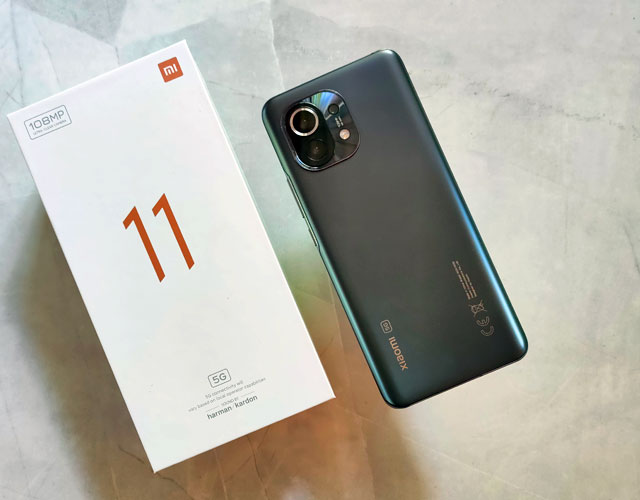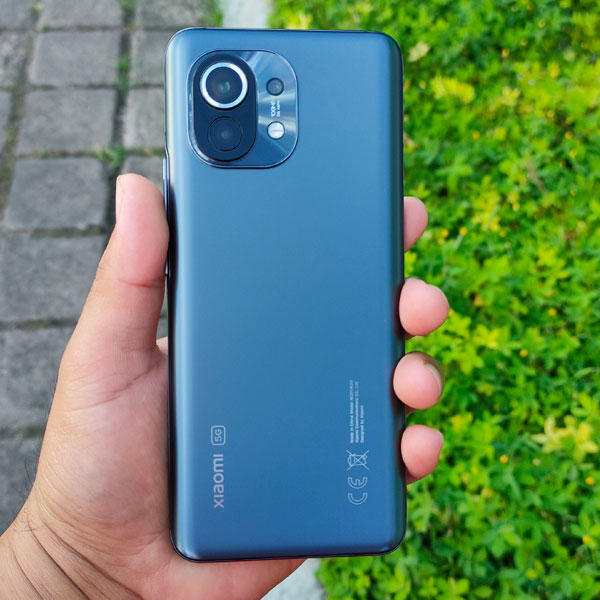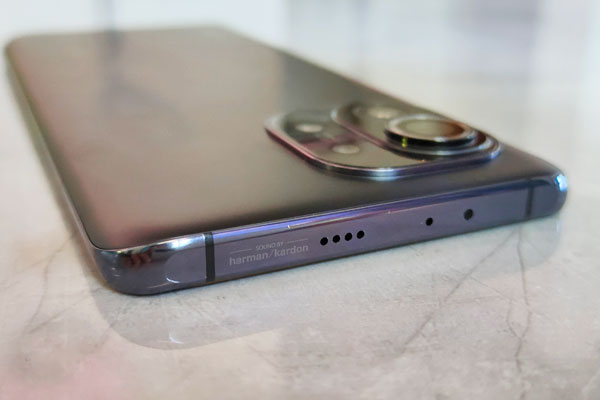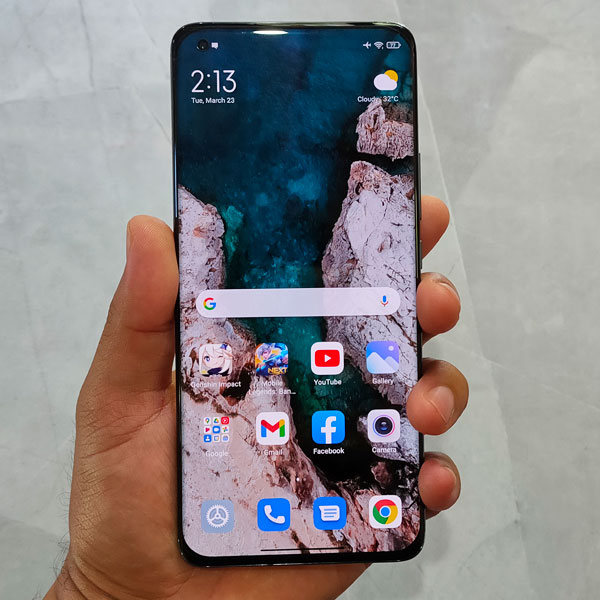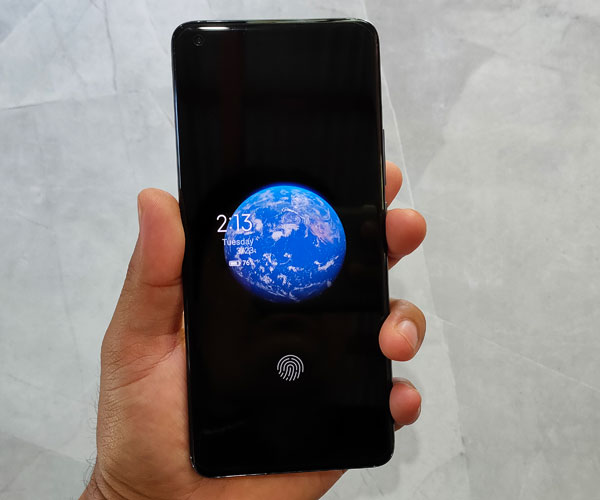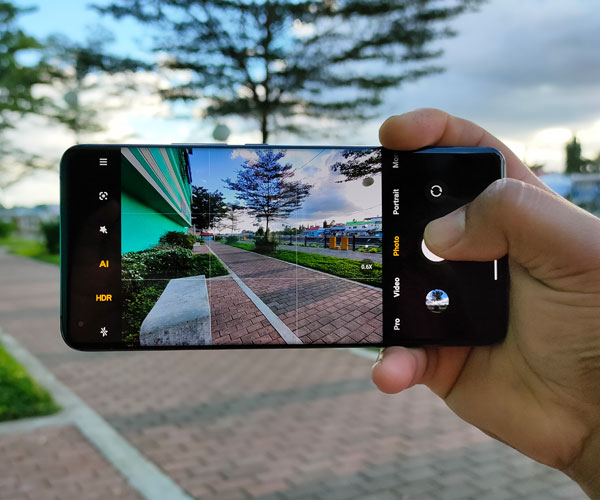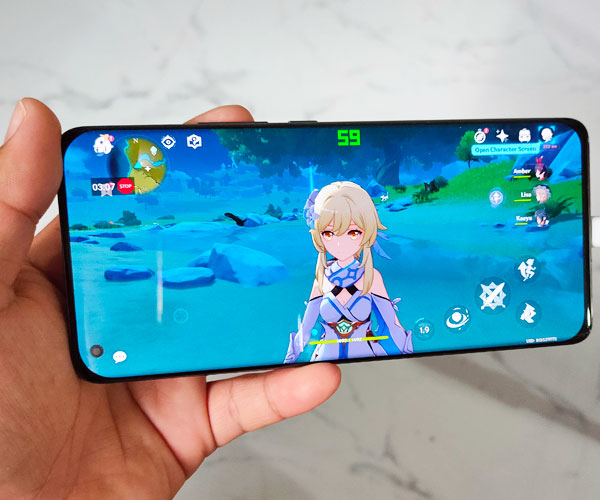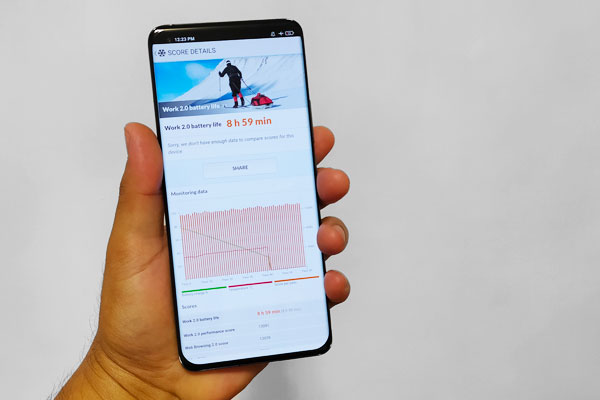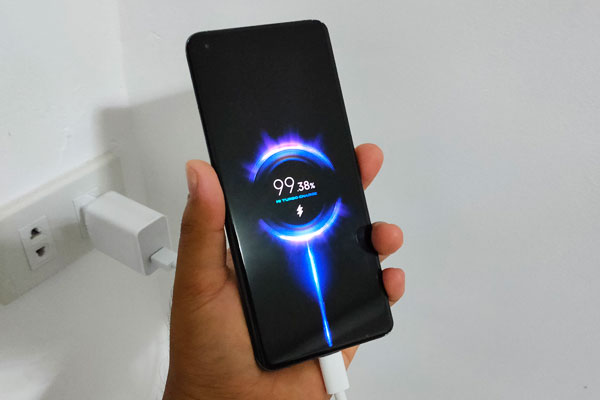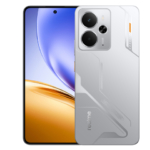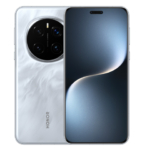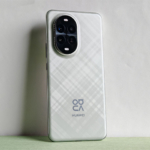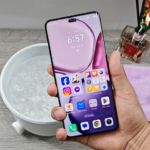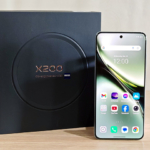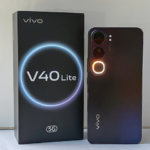The Xiaomi Mi 11 is a flagship smartphone that features a 108MP triple camera matrix, 6.81-inch AMOLED display with 120Hz refresh rate, Snapdragon 888 chipset, and 55W fast charging technology.
I’ve been using the device for three weeks while testing its gaming performance, camera quality, battery life, and overall experience. Here are my thoughts and observations…
What I like about the Xiaomi Mi 11:
- Impressive performance
- Polished flagship design
- Top-notch display quality
- Very capable cameras
- Fun cinematic & vlogging tricks
- Useful extra features
What I dislike about the Xiaomi Mi 11:
- No dedicated zoom camera
- Slight thermal issue
- Unreliable fingerprint scanner
Design and Build Quality
At first glance, the Xiaomi Mi 11 has an unmistakable profile thanks to its camera matrix. It’s a rounded square that slightly protrudes at the back with a large chrome ring around the 108MP main camera.
There are two color options for the device and I have the more subtle Midnight Gray instead of the glossy Horizon Blue. Its back is a Gorilla Glass 5 panel with a matte look but still retains smudges and fingerprints.
It has curved sides on both the front and back with the front panel using the more advanced Gorilla Glass Victus. This makes it look and feel thinner compared to its 8mm official thickness.
A slim Aluminum frame surrounds the device with a flattened top and bottom. The power and volume buttons are found on the right side while on the bottom are the SIM card tray, USB Type-C port, and loudspeaker. At the top are the IR blaster and a small speaker grille for the earpiece.
There are several markings on the phone including “Xiaomi 5G” at the back, “108MP” near the camera, and “Harman/Kardon” at the top. It adds flair to the design but can be a bit much if one prefers a minimal design.
At 196g, the phone has some heft but just enough to make it feel sturdy. I would still recommend a case for this smartphone though because it can be quite slippery due to the curved sides and glass panels.
It’s a polished flagship smartphone in terms of design. It has “character” but still looks quite similar to other premium smartphones.
Display
The Xiaomi Mi 11 has a 6.81-inch QHD+ AMOLED display with a 20:9 aspect ratio, 120Hz refresh rate, and a small punch-hole for the selfie camera on its upper left corner. These specs are on par with Samsung’s current flagships!
It’s bright even under direct sunlight thanks to its Sunlight Mode but can also be comfortable to use at night when you need it to be dim and eye-friendly. It supports HDR10+ for brighter videos and 10-bit color depth for over 1 billion colors.
It’s color-accurate with several options for customizations in the Settings in case the user prefers a more vibrant color scheme. There’s also an Always On Display feature that can be customized to always show the clock, super wallpaper, and notification icons when the display is turned off.
The high resolution of this AMOLED screen results in an impressively sharp 515 PPI pixel density while its high refresh rate makes animations and transitions ultra-smooth. As if that’s not enough, the panel also supports a 480Hz touch sampling rate making it one of the most responsive smartphone screens right now.
If there’s one thing I don’t like about the phone’s display, it would be the curved sides. All of its four sides are slightly curved making swiping more comfortable at the expense of occasional accidental touches. This can be solved by going to the Settings and selecting the appropriate edge touch rejection.
Nevertheless, the Xiaomi Mi 11 has one of the best screens in a smartphone right now. It’s bright, sharp, color-accurate, fluid, and highly responsive.
Camera Quality with Sample Pictures
The Xiaomi Mi 11 has a triple rear camera matrix composed of a 108 Megapixel main camera, 13 Megapixel ultra-wide camera, and 5 Megapixel macro camera.
Its main camera uses a Samsung HMX image sensor and uses pixel binning technology to produce 27 Megapixel pictures to keep file sizes manageable. There’s still a full 108 Megapixel mode if desired.
When used as a point-and-shoot camera, the Xiaomi Mi 11 captures great-looking pictures. It doesn’t apply aggressive filters nor over-the-top enhancements so it might not immediately impress the casual smartphone user but purists will love it.
The pictures are more natural-looking with on-point saturation, sharpness, and dynamic range. To get the same effects as other smartphones, the AI feature can be turned on which will apply HDR enhancements automatically.
Its ultra-wide mode produces similar quality pictures as the main camera but with a wider field of view. It just doesn’t match its prowess when it comes to night-time pictures.
Night Mode greatly enhances low-light pictures. This can be automatically triggered by the camera app when it detects low light and enhances the resulting image by extending the shooting time to a couple of seconds.
It’s not as aggressive as other Night Mode features but the results look more realistic and not overly bright. It tries to match what the eyes actually see while reducing the graininess of low-light pictures.
The front camera of the Xiaomi Mi 11 also captures bright and detailed selfies. It has a tendency to overly brighten the image though unlike the more natural products of the rear camera.
For video recording, the rear cameras have a maximum resolution of 8K at 30 fps while the selfie camera can only record up to 1080p at 60 fps. It also features a “movie frame” aspect ratio, VLOG mode that has several sequences, and Movie Effects that are fun video tricks to try.
Still, the most important aspect is the video quality and the Xiaomi Mi 11 produces superb videos. Its 8K capability can be too much for most screens but the 4K 60fps option is the sweet spot.
It offers many features for users who are willing to explore. It’s best for learning photography without the over-the-top enhancements commonly applied by other smartphone brands.
Performance
The Xiaomi Mi 11 is powered by a Qualcomm Snapdragon 888 chipset. It has an octa-core CPU in three clusters headed by a 2.84GHz Cortex X1-based core, Adreno 660 graphics processor, and 8GB of RAM.
It’s a very powerful smartphone when it comes to playing the most resource-intensive games. I’ve played some of the most popular titles including Genshin Impact, Call of Duty Mobile, Mobile Legends, PUBG Mobile, and NBA 2K20.
Most of those games ran at a perfect 60 frames per second. Genshin Impact ran at 51 fps only but this game is notoriously unoptimized. NBA 2K20 also achieved 90 fps on the Xiaomi Mi 11 since the device supports a high screen refresh rate of up to 120Hz.
However, it has a slight thermal problem as it can reach 43°C to 45°C while playing these games for a prolonged duration. This can be uncomfortable especially when not using a phone case.
| Smartphone | RealPi Benchmark Score | |
|---|---|---|
| Xiaomi Mi 11 | 1.06 s | |
| OPPO Find X2 Pro | 1.53 s | |
| Huawei P30 Pro | 1.82 s | |
| Huawei nova 5T | 1.82 s | |
| realme X3 | 2.02 s |
In terms of general performance, the device runs just as expected for a flagship smartphone. Animations are smooth, app launches are quick, and transitions are fluid.
It achieved the fastest time among the smartphones that I have reviewed in the RealPi Benchmark. It was able to calculate 1 million digits of Pi in 1.06 seconds only!
The 120Hz screen refresh rate should be turned on in the Settings to experience the smoothest performance on the device. Its hardware has no problem keeping up with the high refresh rate and it will automatically scale down when viewing static content such as pictures to save battery.
It’s a very powerful smartphone thanks to its top-of-the-line specs. It operates smoothly and can run the heaviest games easily although there’s a slight thermal concern.
Software and Security
The Xiaomi Mi 11 comes with MIUI 12.5 software out of the box. It runs on top of the Android 11 operating system but with heavy customizations.
There might be some concerns when it comes to the MIUI software but it’s actually neat and intuitive. Intrusive ads are absent here which is great since it might turn off users who expect a pristine smartphone UI for a flagship smartphone.
Of course, MIUI is known for its customization features. There’s an abundance of themes for the device as well as wallpapers and icons. Although, it’s unfortunate that it doesn’t have some of the extra software features of its competitors such as desktop mode.
A new feature that I love is the new Super Wallpaper that includes Earth and Mars. It starts with the whole planet rotating in the lockscreen and zooms in into a specific location when the phone is unlocked.
For security, the Xiaomi Mi 11 offers the usual PIN, pattern, and password. It also has Face Unlock and an under-display fingerprint scanner but the latter has difficulties in unlocking the phone when your finger isn’t pristine.
Connectivity and Sound Quality
The Xiaomi Mi 11 is a 5G smartphone with support for Wi-Fi 6 standard. Unfortunately, there’s still no 5G coverage in our area so I was only able to test its 4G LTE-A performance. It still provided high-speed mobile internet connectivity but I wish I could have experienced how it fares when connected to 5G networks.
It also has other advanced connectivity features including dual-band GPS, NFC, Bluetooth version 5.2, and an IR blaster. The last one turns the smartphone into a universal remote controller for many appliances – a staple feature with Xiaomi smartphones that should be copied by other brands.
The device has a dual stereo speaker system. There is a regular loudspeaker at the bottom and an earpiece with a top-facing grille and a front-facing slit at the top. The audio output is tuned by Harman/Kardon so it sounds impressive.
It sounds more balanced compared to the stereo systems of other smartphones when watching videos. However, the bottom loudspeaker can be accidentally blocked when playing games.
Battery Life and Charging Time
| Smartphone | PCMark Battery Life Test | |
|---|---|---|
| realme X3 SuperZoom | 14 h & 37 min | |
| Huawei P30 Pro | 14 h & 8 min | |
| Samsung Galaxy S10 | 9 h & 1 min | |
| Xiaomi Mi 11 | 8 h & 59 min | |
| OPPO Find X2 Pro | 8 h & 56 min |
A built-in 4600mAh battery powers the Xiaomi Mi 11. It usually lasts for an entire day on a single charge with my normal usage while playing heavy games like PUBG Mobile drains the battery in around 7 hours.
In the PCMark Battery Life Test 2.0, the device scored 8 hours and 59 minutes which is normal for flagship smartphones. However, it needs a lot more to compete with the battery life offered by Huawei’s flagship smartphones.
The test simulates continuous usage through different tasks like web browsing and video playback. I always set smartphones that I review in airplane mode and 50% screen brightness for this battery life test.
Meanwhile, re-charging the Xiaomi Mi 11 from 0% to 100% battery capacity takes 56-58 minutes. This is using the 55W fast charger bundled with the phone when purchased from legitimate stores in the Philippines.
It also supports wireless charging and can serve as a wireless charger itself for other gadgets specially TWS earphones.
Conclusion
The Xiaomi Mi 11 is a flagship smartphone with a polished design, impressive screen, highly capable cameras, fun video tricks, great performance, decent battery life, and a competitive price tag.
I highly recommend it for its 120Hz AMOLED display and overall gaming performance. You’ll have to use a phone case though for thermal insulation and overall comfort.
There are still some features that are not present in the device such as a dedicated desktop mode and high optical zoom but the basics are fully covered. It may not have all the bells and whistles but it also has its useful extra features like the IR blaster.
Finally, the Xiaomi Mi 11 has an official price of ₱36,990 in the Philippines. That’s more affordable than other flagship smartphones in the Philippines. Its main competitors in this price segment are the Samsung Galaxy S20 FE, OnePlus 8, and Huawei P40.
Xiaomi Mi 11 Review Summary
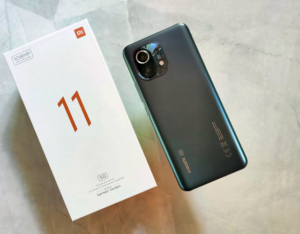
The Xiaomi Mi 11 is a flagship smartphone with a polished design, impressive screen, highly capable cameras, great performance, decent battery life, and a competitive price tag.
- 6.81-inch QHD+ AMOLED Display (1440 x 3200 Pixels), 515 ppi
- Android 11 Operating System
- Qualcomm Snapdragon 888 Chipset
- 8GB of RAM
- 108 Megapixel Rear Camera with Dual-tone LED Flash
- 20 Megapixel Front Camera
- Dual SIM
- 256GB UFS 3.1 Internal Storage
- 5G, 4G LTE, 3G HSPA+, 2G EDGE & GPRS Networks
- Wi-Fi 6
- Bluetooth 5.2
- USB Type-C
- USB Type-C
- Fingerprint Sensor
- 4600mAh Battery
- 55W Fast Charging (100% in 45 minutes), 50W Fast Wireless Charging (100% in 53 minutes), 10W Reverse Charging
- ₱36,990.00 Official Price in the Philippines
